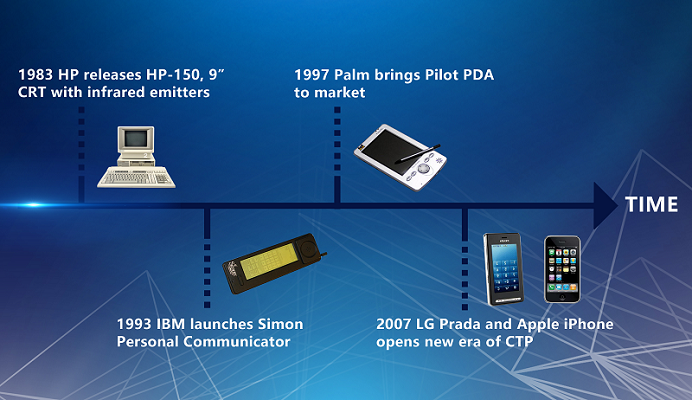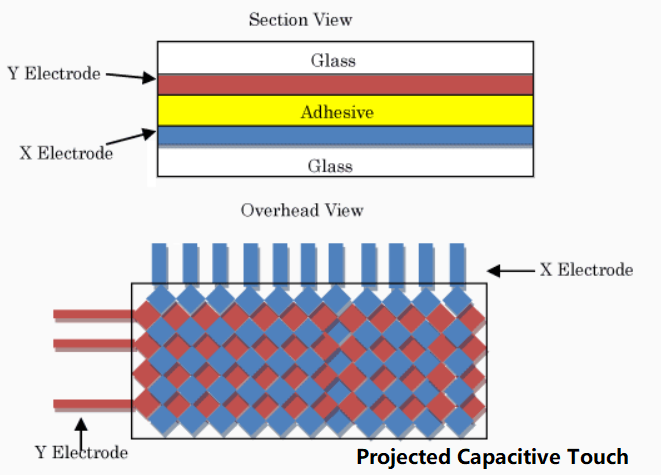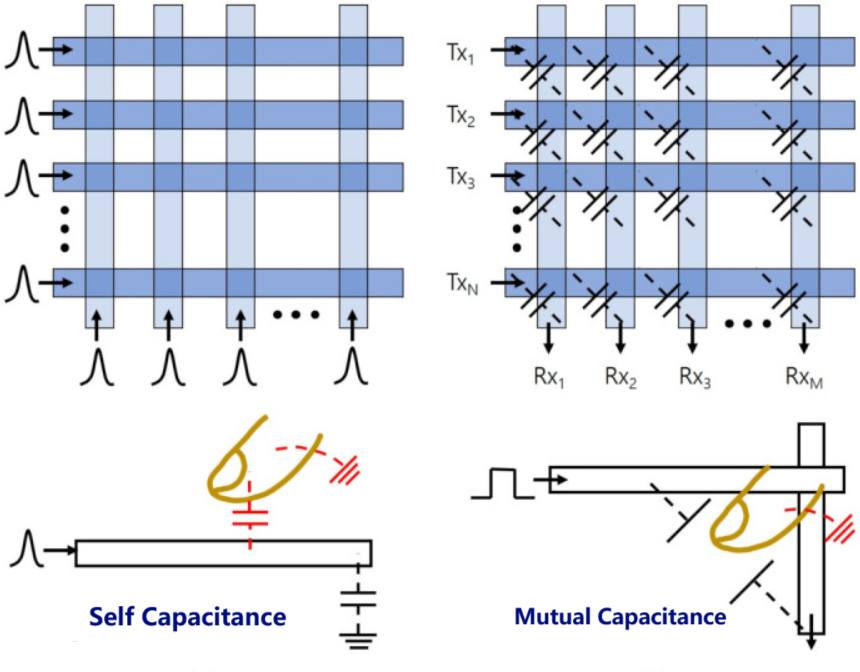What is Projected Capacitive Touch
Projected Capacitive Touch is the most used touch technology nowadays. It provides a readily accessible, low cost, low power solution to facilitate implementation of rich features touch-screen user interfaces. Before diving into what is projected capacitive touch, let's go over some basic about touch screen technology.
Brief History of Touch Screen
There are many types of touchscreen. Among them, resistive touch and capacitive touchscreens are the ones commonly used today.
The world's 1st finger-driven touchscreen was invented by E.A. Johnson for a UK radar station at 1965. It was not until 1983, a commercial product launched by HP. HP-150 is a computer with 9" CRT touchscreen. The screen is surrounded by infrared (IR) emitters, used to sense user's touch.

In the 90s, touchscreen devices went main-stream, leading by IBM's Simon Personal Communicator and Palm Pilot. These hand-held devices were built with resistive touch and stylus. 2007, LG's Prada smart phone and Apple iPhone open up a new era of capacitive multi-touches screen.
Capacitive Touch Screen
In essence, this is the ability of a touchscreen to carry an electric charge, and for that charge to be drawn off or changed in some way, as a finger or suitable conductive stylus or object approaches. Capacitive touch can be divided into surface-capacitive and projected-capacitive.

Surface-capacitive touchscreens consist of one conductive layer of which four corners are connected to four synchronized alternative current (AC) voltage signals. Finger touching the screen brings out different currents from four voltage sources. As a result, touch controller can use the difference to calculate touched location. Due to its technical limitation, surface capacitive touch can only detect one touch point at a time. And it can only work with conductive object. Whereas projected capacitive touch, it overcomes those shortcomings.
What is Projected Capacitive Touch Screen
Projected capacitive touch technology is a newer type of touch technology that uses grid-like array of intersecting rows and columns to which an electrostatic field is applied to detect touch. When a finger or a conductive stylus approaches an electrode, it disturbs the electromagnetic field and alters the capacitance. This change of capacitance can be detected by touch controller and projected the touch position(s) within the X and Y layers. The controller then passes this data in the form of X-Y coordinates to the host computer.

Projected capacitive method can be further divided into two groups, self-capacitance and mutual-capacitance. Self-capacitance measures capacitance change between touch point and ground. As for mutual-capacitance, it measures touch point's capacitance change between overlapped area of horizontal and vertical ITO electrodes.

Self-Capacitance
When a finger touches self-capacitance touchscreen, horizontal (x-axis) and vertical (y-axis) capacitance changes (relative to circuit ground) are detected, projected (x,y) position is recorded. However, when 2 points are touched, projected self-capacitance screen can recognize touches at x1, x2 and y1, y2. But it can't tell whether touch points are at (x1,y1), (x2,y2) or (x1,y2), (x2,y1).
Mutual-Capacitance
On the other hand, since mutual-capacitance touchscreen measures overlapped capacitance in relative to horizontal and vertical electrodes, which means touch point's horizontal and vertical position is fixed. Therefore, projected mutual-capacitance touchscreen can support multiple touches. And it is the most used CTP technology in market now.
Construction of Capacitive Touchscreen
There are three ways in embedding CTP with LCD. They are In-Cell, On-Cell and OGS. Each of them has different pros and cons.
Summary
Projected capacitive touchscreen has become a mainstream technology, especially, the mutual capacitance touch. It is the most widely used technology on many consumer electronics such as smartphones, laptop PCs, tablet PCs, and smartwatches, because of its multi-touch support, slim form factor, high optical quality, excellent durability, smooth scrolling, and so on.
Topway has been pushing projected capacitive touch display to industrial applications for many years, because of its following advantages.
- It has no moving part in operation, which leads to relatively long operating life.
- Glass finishing makes projected capacitive touchscreen less susceptible to scratch and impact, thus more durable.
- Projected capacitive touchscreen has excellent optical property.
- Sensor's sensitivity can be adjusted to suit different working conditions, like addition of cover lens, operation with gloved fingers.
Write to us about your next touchscreen project, we are confident that we can make the project a successful one.
